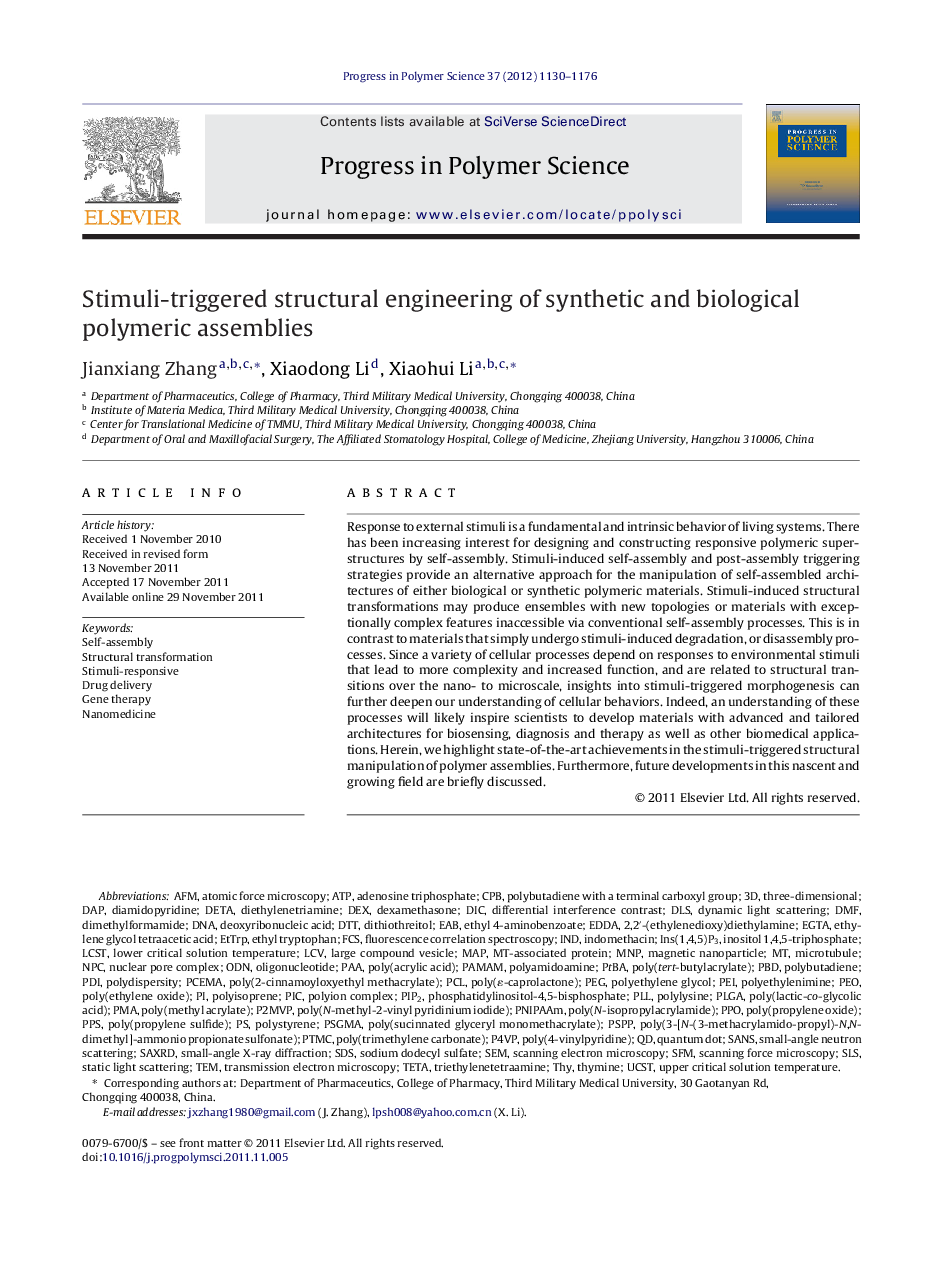| Article ID | Journal | Published Year | Pages | File Type |
|---|---|---|---|---|
| 5208549 | Progress in Polymer Science | 2012 | 47 Pages |
Abstract
Response to external stimuli is a fundamental and intrinsic behavior of living systems. There has been increasing interest for designing and constructing responsive polymeric superstructures by self-assembly. Stimuli-induced self-assembly and post-assembly triggering strategies provide an alternative approach for the manipulation of self-assembled architectures of either biological or synthetic polymeric materials. Stimuli-induced structural transformations may produce ensembles with new topologies or materials with exceptionally complex features inaccessible via conventional self-assembly processes. This is in contrast to materials that simply undergo stimuli-induced degradation, or disassembly processes. Since a variety of cellular processes depend on responses to environmental stimuli that lead to more complexity and increased function, and are related to structural transitions over the nano- to microscale, insights into stimuli-triggered morphogenesis can further deepen our understanding of cellular behaviors. Indeed, an understanding of these processes will likely inspire scientists to develop materials with advanced and tailored architectures for biosensing, diagnosis and therapy as well as other biomedical applications. Herein, we highlight state-of-the-art achievements in the stimuli-triggered structural manipulation of polymer assemblies. Furthermore, future developments in this nascent and growing field are briefly discussed.
Keywords
PEIAFMPDIPLGADLSDMFSDSDEXPCLThree-dimensionalDICP4VPCPBPAASLSDTTEGTADAPUCSTPICSfMPPOFCSODNNPCPLLPsPPPBDMNPEABPIP2LcstPNIPAAmPolyisopreneLCVPTMCEDDADETAPoly(propylene sulfide)ptBADNAInositol 1,4,5-triphosphateIns(1,4,5)P3PMAPpsAdenosine TriphosphateATPethylene glycol tetraacetic aciddeoxyribonucleic acidindIndomethacinOligonucleotideTemSANSStructural transformationDrug deliverytriethylenetetraamineThythymineTETASelf-assemblyUpper critical solution temperatureLower critical solution temperatureDexamethasoneDiethylenetriaminedimethylformamidedithiothreitolMicrotubulesodium dodecyl sulfatefluorescence correlation spectroscopyphosphatidylinositol-4,5-bisphosphatenuclear pore complexStimuli-responsiveSEMScanning electron microscopyTransmission electron microscopyatomic force microscopyScanning force microscopyMagnetic nanoparticleNanomedicinemapquantum dotPAMAMSmall-angle X-ray diffractionSmall-angle neutron scatteringstatic light scatteringDynamic Light ScatteringPoly(4-vinylpyridine)Poly(N-isopropylacrylamide)Poly(ɛ-caprolactone)poly(lactic-co-glycolic acid)Poly(propylene oxide)Poly(trimethylene carbonate)PolyamidoaminePolyethyleniminepoly(ethylene oxide)polyethylene glycolpoly(acrylic acid)PolybutadienePoly(methyl acrylate)Polyion complexPolydispersityPolylysinePEGPolystyrenePEOGene therapydifferential interference contrast
Related Topics
Physical Sciences and Engineering
Chemistry
Organic Chemistry
Authors
Jianxiang Zhang, Xiaodong Li, Xiaohui Li,
